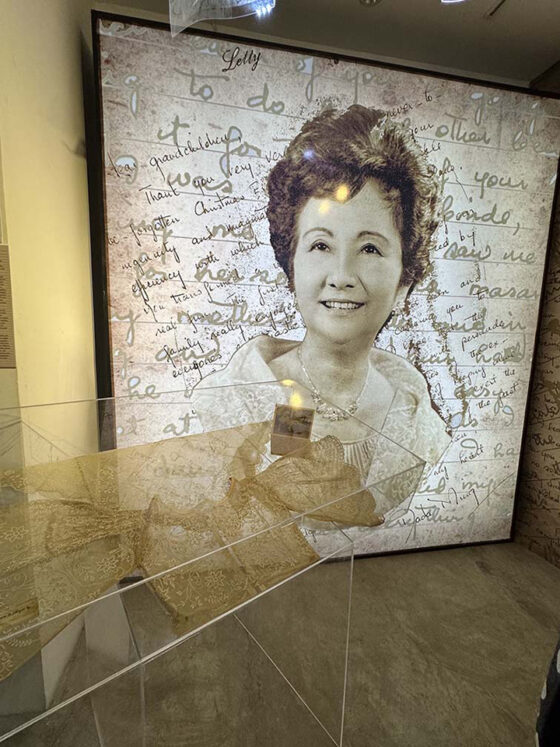
By JT Nisay | Published by BusinessMirror | April 15, 2025
IT was an almost impossible task.
How does one curate a retrospective exhibition of someone like Letizia Roxas Constantino, a multihyphenate extraordinaire who dedicated her life to excellence in every pursuit, from writing history books meant to inspire the nation, to playing the piano, and even doing the grocery list? There are 80 years’ worth of materials to review—composed of an ocean of letters, notes, documents—all while dealing with the grief over the subject even nearly a decade after her passing, as she happens to be your grandmother, your matron of honor, your “best friend.”
Broadcast journalist Karmina Constantino-Torres took on the challenge nonetheless and offered a simple, eloquent answer on how she managed.
“What made [the task] difficult was also the one that made it easy,” she said, “and that was the love that we have for her and the love that she had for us.”
Grace, intellect, heart

THE Constantino Foundation (www.constantinofoundation.org) was established in 1976 by husband-and-wife historians Renato and Letizia Constantino to advance the idea of usable history, “where lessons from the past become active elements of the present.” On April 9, the organization opened a tribute exhibition dedicated to one of its former presidents, Letizia, to commemorate her 105th birth anniversary.
Titled Letizia: A Life in Letters, the multi-sensorial exhibit celebrates the subject’s life and legacy as a writer, historian, political analyst, dancer, and classical pianist. It also covers her roles as a loving wife, mother, friend and lola, presented through carefully selected mementoes, diary entries, and other materials. The exhibit runs until May 30 at the Linangan Gallery of the Constantino Foundation on Panay Avenue, Quezon City.
According to Letizia’s grandson, Red Constantino, the foundation’s managing director, the show is not something to be seen but to be experienced. It is a show that “reflects the grace, intellect and heart” of her grandmother, honoring “the nationalist, the historian, the writer, and the generational Filipina that she was.”
“The exhibit represents a sliver of a fingernail of letters, manuscripts and other artifacts that we work on, which represents an incredibly tiny fraction of what remains covered in boxes inside the Constantino Foundation’s compound,” Red said during the exhibit opening. “There’s more than enough material to review or discover for new books, documentaries, or even novels. But that is a tomorrow challenge. Tonight, until May 30, we will honor Letizia.”
‘Better than diamonds’
THE late, great writer was born on April 9, 1920. She lived a full life until her passing on June 27, 2016, leaving behind a legacy characterized by purpose and passion. One of Letizia’s great friends, scholar Inday Ofreneo, wrote in a book that she was so gifted in various fields that she could have even been a great concert pianist.
“But love steered her to another direction not as glamorous but no less demanding,” Ofreneo wrote. “Today, we are all the richer for that twist of fate; from piano to pen.”
Presented in the Letizia: A Life in Letters are carefully selected materials from the stacks and stacks kept in the organization’s compound. Actual and projected handwritten letters of Letizia fill the intimate space, along with photos and artifacts, while her piano recordings play in the background. There is a special installation as well, showing the illusion of pages coming to life from Letizia’s actual desk, floating, and suspended mid-flight.
One letter is addressed to her son, RC. Letizia thanked him for writing about her birthday in his column on the news magazine Isyu in 1997. “Thank you, thank you for your love, for your support, for the way you have touched my heart. My best gift! Better than diamonds.—Ming”
Other notes chronicle Letizia’s daily schedule, segmented into hours, a testament to her obsession with details. There are also recordings of recipes and meals served to guests.
Meanwhile, a prominently featured piece shows a photo of Letizia with her husband, Renato. Below it is a text, which reads: “To make a contribution ‘towards the emergence of the decolonized Filipino’ was the loom upon which they had chosen to weave the fabric of their lives.”
Letizia and Renato penned several historical and nationalistic books, including the seminal 1975 title The Philippines: A Past Revisited. Letizia shied away from the spotlight, to the point that she insisted her name to be listed only in the book’s inside title page as “With the collaboration of Letizia R. Constantino.” On the 1978 second volume, however, Renato insisted on a more proper attribution, which is why The Philippines: The Continuing Past carry both their names.
Her heart in her words
THE man behind the exhibit design was artist Ohm David. During the show’s opening reception, he shared that Karmina, the curator, reached out to him on January 9, mere months before the show.
“How hard could it be?” David, also a renowned stage designer, recalled thinking to himself when told the exhibit was to be centered on pictures and letters. “And I was never so wrong in my life.”
He remembers being confronted with “tons and tons of letters, books and pictures.” They narrowed down the choices, reviewed the selection, and he gained a better understanding of the subject. David believes Letizia guided him throughout the process.
“When you read the letters, it’s like she’s talking directly to you,” he said. “That’s how loving and caring she was and you feel it through her writings.”
Whether it’s managing expenses for the house or talking to her grandchildren about marriage, or rallying the nation, David noted that Letizia “put all her heart” in her letters. He hopes that through the exhibit, viewers would come out not only knowing more about the Letizia, but seeing more of themselves through her letters.
‘Dada Ming should not be the last of her kind’
A FREQUENT recipient of Letizia’s heartfelt, handwritten letters was her granddaughter, Karmina. Over the years, Karmina has built a strong reputation as a hard-hitting journalist, a figure of courage who does not back down from asking the tough questions. During the exhibit opening, however, Karmina was reduced to tears, even nearly a decade after the passing of her beloved grandmother.
“Well, iyakin talaga ako, to begin with,” Karmina said, smiling, while her eyes welled up. “Nothing moves me as much as family does.”
Karmina and her “Dada Ming” shared a bond like no other, as her grandmother did with cousins and siblings, she said. “Such was her gift,” Karmina added, that receiving a letter from Letizia would make “you feel as if you’re the single most important person in the world.”
And then there was her grandmother’s inimitable appreciation of life. Karmina said her lola found beauty in everything—how nothing was mundane. There was a time when they were driving around and noticed a “beautiful tree.” Without skipping a beat, Letizia asked the driver to pull over, and they stepped out of the car to “spend about five minutes just looking at the tree.”
“That’s how special she was,” Karmina said. “There was nothing ordinary about life.”
Among Karmina’s most treasured, featured pieces in the exhibition is a stuffed toy, a little bunny. It went with a bouquet she gave to her lola as a birthday present, dated April 9, 1998. Letizia kept it and made a note that read: “Given to me by Karmina—to be kept for her first baby.”
“How can someone be so thankful in that moment enough to spur her to show that gratitude in the future?” Karmina said during our conversation, shaking her head in disbelief.
“I gave her that bunny, but in the end I was the one who was thankful.”
Years passed and both Karmina and her lola forgot about the gift. It wasn’t until after Letizia’s passing that Karmina unearthed the bunny. To honor her grandmother’s note, Karmina gave it to her youngest child, her only daughter, whom she named after her lola.
Karmina had given birth to three boys before the younger Letizia came along. She remembers engaging a friendly banter with her lola about her having a daughter—“ikaw dapat magkakababae”—to which Karmina would play around and juggle her responses between “we’re working on it” and “wala na.” When her grandmother passed in 2016, however, Karmina said “there was a desperate search for connection.”
“I was like, I’m going to have that baby. I’m going to have that daughter,” she said. After two failed IVFs and two miscarriages, Karmina began to lose hope. She prayed and told God: “If it’s not meant for me, it’s okay. But it’s this longing that I need help with. So, help me with the longing and I’ll be okay.”
The following month, Karmina got pregnant. The younger Letizia was born on June 27, 2020, the same day her namesake passed in 2016.
“My husband would tell me, you willed her into life,” Karmina said. “And I’m like, no, kami ni Dada Ming, we dreamed her into life.”
Moments earlier, Red remarked about cosmic connections, particularly in the confluence of dates surrounding the occasion. He noted how their father, R.C. Constantino, passed on April 4, which happens to be the birthday of their maternal grandmother. Meanwhile, RC’s birthday, September 15, coincides with the day of the passing of their lolo, Renato, in 1999. Then, of course, there’s little Letizia and her great grandmother.
“Perhaps, these will all remind us that history is not about endings,” Red said.
“It is about renewal.”
As for the exhibit, it’s all about celebrating the great life of her lola, according to Karmina. With all the featured handwritten letters, she said that the hope—at the very least—is for the public to once again fall in love with writing letters.
“May it spur them to write tonight,” she said.” There’s something so romantic and magical when you write. But I hope as well that when they walk through the exhibit, they will see how remarkable she was. And that they also find their way back to themselves, and think that [Dada Ming] should not be the last of her kind.”

